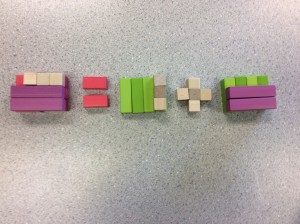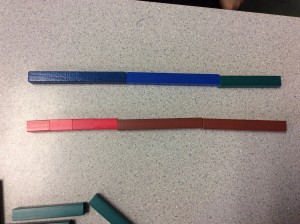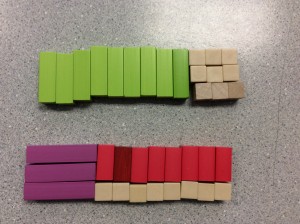May 29, 2016
Here are a couple more warm up problems:
Neither problem seems difficult at the outset. I am happy with their visual simplicity. On the other hand, it would take a bit of work to explain how the answers were derived.
May 18, 2016
I’m very pleased with the Math problem I posed my class today. It was accessible for all students. The question I asked was, “How many rectangles are there in total?” It sounds like an easy question to start with.
Muddy Points: A couple of students asked, “Is a square a rectangle?” Another student adamantly argued that squares cannot be rectangles. Both were good opportunities for conversation.
Indicator of the Level of Difficulty: After they had worked for a while, we looked at their solutions and noticed that no two pairs had come up with the same answer.
Communication: Many of the diagrams were impossible to understand. Others said, “I counted in my head.” However, we had no way of knowing if they were right or not because nothing was written down.
Prompting: Eventually, I found one example on the board where someone had the beginnings of a table to show their answers. This was helpful so I encouraged that. Here is the problem. (Click and the pdf will open up.)
This problem was inspired by Fred Harwood, my Math mentor.
May 11, 2016
Math Club this year has been powerful. We meet for about an hour once a week. Mr. Fred Harwood has been our mentor and guide. There are two teacher sponsors: Mrs. Cori Anderson and me. We’ve had a core group of members all year with one member dropping out early and a few more joining as the year progressed. Grade Six and Seven students were invited to write the Gauss Math Contest at lunch (and into the block after lunch today) thanks to Cori. We then corrected the Gauss during Math Club. Math Club is great because of:
- the camaraderie and social aspect
- the learning (for all levels)
- the buzz, the energy
March 30, 2016
Today we were showing 2/3 + 1/4 using Cuisinaire Rods. I walked around and took photos with my iPad which was connected to the Air Server and therefore projecting on the screen in real time. The first set of photos is a sampling of how this operation was represented in the first half of the class. (No paper and pencil allowed today!)
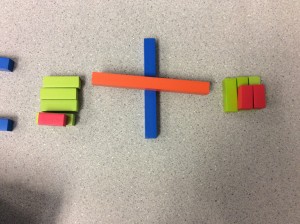
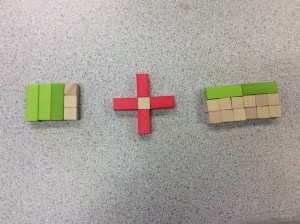

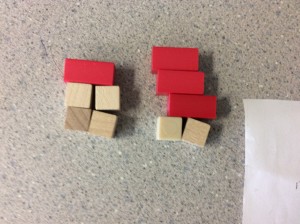
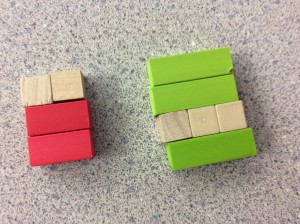

Yikes! Did you see what was going wrong each time?
Intervention: I told the class that John and I were each going to eat a piece of cake. I was going to get 2/3 of a cake and John was going to eat 1/4. I said this wasn’t fair because his piece was much bigger. How is this possible?
Once we collectively realized that cake size matters, we looked at the previous photos again and re-evaluated them.
Then I asked the students to repeat the task of showing 2/3 + 1/4. Here is the post-intervention batch of photos.
I’d say we went from about 20% accuracy (twenty percent of students doing the task accurately to start) to about 85% accuracy by the end of the lesson. After I had taken the photos, I called students up to describe the pictures projected on the screen and they told us whether or not each of the latter representations was accurate or not and why.
Next step: When they mark this up with writing and speech (in addition to photos) using the EduCreate app, will this documentation reveal additional misconceptions? Will the process of documenting solidify their learning?
March 19, 2016
Teaching is a struggle. Don’t let anyone tell you this isn’t so. Think about it. You have 30ish students. Each one from a different home. Each one with different interests. Each one with a different personality. Many students have had different teachers. Even if they had the same teachers, they probably reacted to the teachers differently. Best case scenario: identical twins, with the same teachers, same environment, yet different personalities. Wha??? Ready to throw your hands up and give up? If not, you are probably a teacher.
Teaching Math is a particular struggle. Many parents have Math phobias which they pass along to their kids. Many teachers have Math phobias which they pass along to their kids. These Math phobias are a result of a fixed mindset instead of a growth mindset. A fixed mindset says, “I can’t do x.” A growth mindset says, “I cannot yet do x. But if I try, I will be able to.” Any elementary school teacher has the responsibility to develop enthusiasm for teaching Math and for adopting a growth mindset in this area. And yes, I believe we can all do it.
Teacher fractions is the worst struggle. So let’s start with fractions and make this do-able. After this, everything is possible.
